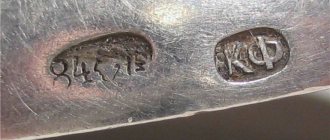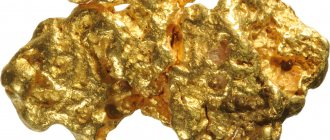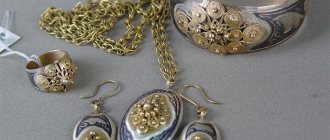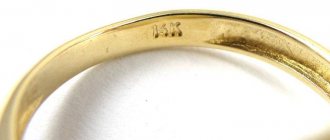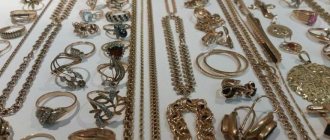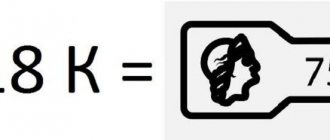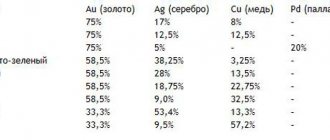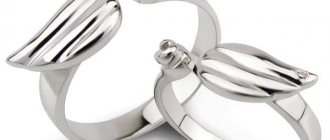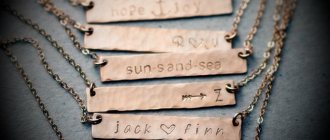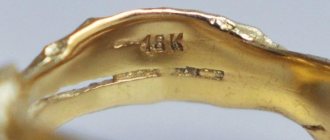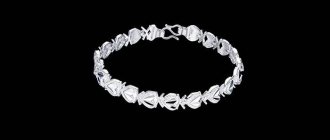Jewelry is quite an expensive item. And where there is an impressive cash flow, there is always the temptation of easy money. That is why the state very strictly controls the process of manufacturing and selling jewelry.
Any ring made of precious metal that you purchase in a store will be equipped with a sealed tag indicating the weight, price and other characteristics of the product. But even if you remove it, the ring will remain proof that it is made of precious metal - there is an assay mark for this.
What types of gold are there?
In jewelry, there are four types of samples - the so-called “quality marks”. Today, only two are used for marking gold products.
The numbers indicate the quantitative degree of precious metal content in the total weight of the object, everything else is impurities. The higher these indicators, the more precious the product is considered.
Tests are made when the percentage of precious metal presence exceeds 30. In Russia, some manufacturers also use name letters in engravings, denoting their organization with them.
Where is it located and what does it look like
The location of the sample depends on the type of decoration. On rings it is usually placed on the inside or outside of the shank - a ring that covers the finger, on earrings - on a pin or earring, on pendant jewelry - on rings for hanging, and on a bracelet - on a link, between the item and the lock. But any master tries to make the mark miniature and invisible, so it is better to study it with the help of a lens.
The mark of the state Assay Inspectorate is a contour of two rectangles, called a “shovel”, inside of which there are: the profile of a girl in a kokoshnik looking to the right, the code of the State Assay Inspectorate and numbers indicating the content of pure gold in the alloy. The shape of the outline varies depending on the metal from which the product is made. For items made of silver, this is an oval cut on both sides; for items made of platinum, it is a horizontally oriented elongated octagon. To this day, items made in the USSR are common, on which a star is placed in the outline of the standard mark of Russian gold products. At the same time, the shapes of the sample contours for different metals did not change.
Another mandatory mark, usually placed next to the sample, is the so-called name tag. It contains four Russian letters that encrypt information about the manufacturer. It is not difficult to decipher the name code. The first letter indicates the year of manufacture, for example, “A” - 2001, etc. The second is the state assay inspection body that carried out the control. The remaining two letters are the manufacturer’s code, which is not repeated within the service area of one inspection. The restoration of the item is indicated by the letter “R” (restoration) placed next to the nameplate. Organizations and individual entrepreneurs producing products from precious metals are required to register their names with territorial assay supervision offices and leave their imprints on their products. Thus, assay marks and name marks tell about the type and standard of the metal, the manufacturer, the time of manufacture and the assay authority that affixed the mark.
Carat system
It has been widespread in America, as well as in Europe and Asia for about a century. According to it, gold with 99.9% in the alloy can be considered completely pure, which is identical to 24k. Further figures in descending order are 23, 22, 18, 14, 12, 9 and 8 carats.
Metric system
The most popular method of calculation today due to its accuracy and convenience. Shows how many percent of gold, without taking into account the ligature, contains 1000 weight particles of the alloy, or the amount of gold metal in 1 g of jewelry. The following scale for measuring gold hallmarks has been established: 375, 500, 583, 585, 750, 916, 958, 999.
Spool system
It was in active use during the times of Ancient Rus'. The Russian pound measuring 96 spools was taken as a basis. The number 96 indicated on the stamp meant that the alloy was 99.9% yellow metal. In second place was the indicator 36. To convert to the modern karate system, the indicator indicated on the engraving is divided by 4.
Lot system
It was in use in medieval Europe. Back then, jewelers measured the weight of the product in marks, each of which consisted of 16 lots. Gold was hallmarked with hallmarks of 6, 8, 12, 14, 16. To convert lots into carats, their indicator was multiplied by 125 and divided by 2.
Over time, the system was improved, and it became easier to find out the percentage of the precious metal included in the composition. In modern jewelry, the metric and carat systems are used as the basis. The first is widespread in European countries, including Russia, while the second is preferred in the West.
Features of branding
The mark is applied to gold in one of three ways: with a laser, a percussion tool, or using the electric spark technique. What are the intricacies of each method and for what cases is each suitable?
- Mechanical application is most common among jewelers. They use hammers as tools; some workshops are equipped with automated machines. For each product, a special stand suitable in shape is selected. The print, as a result of careful application with a machine or a hammer, is clear and durable.
- Electrical erosion is used in cases where the product has a specific shape or requires delicate work. Burning on an electric spark device allows you to apply a permanent mark to fragile alloys without causing any harm to it.
- Laser technology is the most modern engraving method, allowing printing on the smallest precious items and damaged items. Prints come out clear and neat.
Checking with improvised means
Of course, checking using the above methods does not always give a 100% guarantee that what you are looking at is not a fake. Perhaps you did the experiment incorrectly (you didn’t see the sample or the top covering of the table turned out to be too soft) or you still doubt the quality of the gold product.
Then the following available means will come to the rescue: iodine, vinegar and ordinary black bread. Read on to learn how to check.
Iodine
To check authenticity using iodine you need:
- Place 1 drop of iodine on the jewelry and wait 5 minutes.
- Wipe the iodine with a tissue or rinse with water. If the jewelry has changed color and darkened, it is a fake. When darkening, the color of the product changes to gray or black with a greenish tint.
Place one drop of iodine on the jewelry and wait five minutes
Vinegar
Another easy way to check authenticity is to use regular table vinegar:
- To do this, you need to pour a small amount of vinegar into a ceramic or plastic bowl (never an iron one).
- Place the decoration in it and leave for 5-7 minutes.
- Gold will not change its appearance in any way , but the fake will darken.
Nitric acid
Another method of chemically testing gold for authenticity is the reaction to nitric acid:
- To conduct the experiment, place the jewelry being tested in a deep metal bowl and drop 1 drop of nitric acid onto it.
- If the product does not change color to green or milky , it means it is made of gold.
To conduct the experiment, place the jewelry being tested in a deep metal bowl and drop just one drop of nitric acid onto it.
Scratch with a needle
You can also check the authenticity of a gold item using a regular needle. To do this, you need to forcefully scrape the jewelry being tested with a needle. Nothing will happen to real gold. But the gilding will come off easily.
Contact with gold
Every person has a gold item, the authenticity of which he has no doubt:
- In order to carry out the test, you need to: draw a line with real gold on a hard surface.
- Carry out a similar action on the same surface and with the object you doubt.
- There should be no differences between the lines.
You can purchase a special jewelry set with samples of different metals. This way you will determine not only the authenticity of the gold, but also its quality.
Magnet
Every person knows that pure gold is in no way magnetic:
- Apply the product being tested to a magnet and see what comes out of it all.
- If a product is even slightly attracted to a magnet, it is an alloy of metals. Copper can most often be passed off as gold. However, counterfeit gold items often involve metals such as aluminum, copper and tin. They also do not respond to magnetic testing, but are lighter in weight than similar gold products.
lapis pencil
Lapis pencil is a drug for stopping bleeding and treating wounds. You can easily buy it at a pharmacy.
To check the decoration you need:
- Wet the product with running water.
- Draw a line on the wet product with a lapis pencil.
- Wipe off the mark with a dry cloth.
If a pencil mark remains on the surface of the product, this is another fake.
Black bread
For this experiment you will need fresh bread crumb. You can check absolutely any product in this way:
- We take the crumb and wrap the gold product in it.
- Roll into a ball and leave for several days until it becomes stale.
- When this happens, remove the product from the bread. The appearance of gold will not change in any way, but the alloys will undergo oxidation and change color.
Ceramic tile
If you have untreated ceramic tiles at home, you can use them as a gold test:
- To do this, you need to run various metals and the product you want to test over the tile.
- The trail from it should be golden. Other metals will leave behind black and gray streaks.
Reaction to the sun
For this method of verification, you will have to work a little with nature. A bright sunny day is required:
- First, carefully examine the product being tested in the shade. Remember how it shines, what color it is.
- Now we do the same under direct sunlight. Standing on the street, look how bright and presentable the product looks.
- Real gold never loses its appearance in any weather conditions.
Archimedes' method
This verification method is more suitable for large gold items (for example, gold bars). However, it requires some effort and knowledge.
For this experiment you will need a deep container and water:
- Fill the container with water to the brim. You should first find out how much water you have collected.
- Slowly and carefully immerse the gold item in the container and let the water overflow (leak out) over the edges.
- Now let’s remember Archimedes’ law of buoyancy: “A body immersed in a liquid is acted upon by a buoyant force equal to the weight of the liquid in the volume of the immersed object.”
- Using the formula FA=pgV, where p is the density of the liquid, g is the acceleration of gravity and V is the volume of the immersed body, we find out the mass of the gold product. The density of water is 900 kilograms per 1 cubic meter.
According to Archimedes' law, gold must sink. Since its weight is greater than the volume of displaced liquid. The nuances of the method are in the video below.
What does 5s5 hallmark mean on a gold ring?
There is an assumption that such marking is an erased number 585 (since 555 and 500 samples do not exist), applied to the ring using laser equipment. In fact, 5S5 is marked using the electrospark method and fully corresponds to 585 standard.
Sometimes scammers try to fake this sample. How to recognize a fake? You need to carefully examine the boundaries of the marking: with a laser marking they are always clear. Noticeable abrasions and other dubious aspects indicate that this is a fake, and there is no need to purchase it. An example of a visual examination can be seen in the video:
The original hallmark of 585 (14 carats) means that the jewelry contains 58.5% gold and 41.5% impurities. The pink tint of the ring is observed when copper predominates in it.
Methods of applying a brand
There are various technologies for marking jewelry products:
- mechanical branding method. It is the oldest and most popular marking method, used in up to 80% of cases. The technology of mechanical branding is extremely simple: the sample is fixed in a convenient position and an impression is made with a hammer blow. The downside is the risk of deformation of fragile and small specimens;
- electric spark method. The development has been used since the 70s of the 20th century and involves burning a quality mark on jewelry using an electric spark. It is considered an ideal solution for marking jewelry products of the “blown” category with hollow shapes. The print is highly clear and durable. Apply exclusively to a flat surface without pores, roughness or other defects;
- laser method. Marking is carried out using a laser machine, suitable for surfaces of any type, concave, convex and flat, the main thing is that the plane must be highly polished.
The downside is that the laser method is complicated and requires considerable investment, and the print is subject to wear.
Soviet 583 gold standard
How much does this sample cost?
The presented type of mark is very popular among buyers, since it speaks of the strength of the product, ensured by the balanced percentage combination of precious metals in it.
The market price of gold changes almost daily, so the exact cost of 1 gram of 585 marking currently needs to be found out in specialized institutions. In jewelry stores, the price of pure gold is a third higher than in pawnshops.
| Price 999 standard according to the Central Bank | Market value of the sample today | Scrap price | Price in jewelry |
